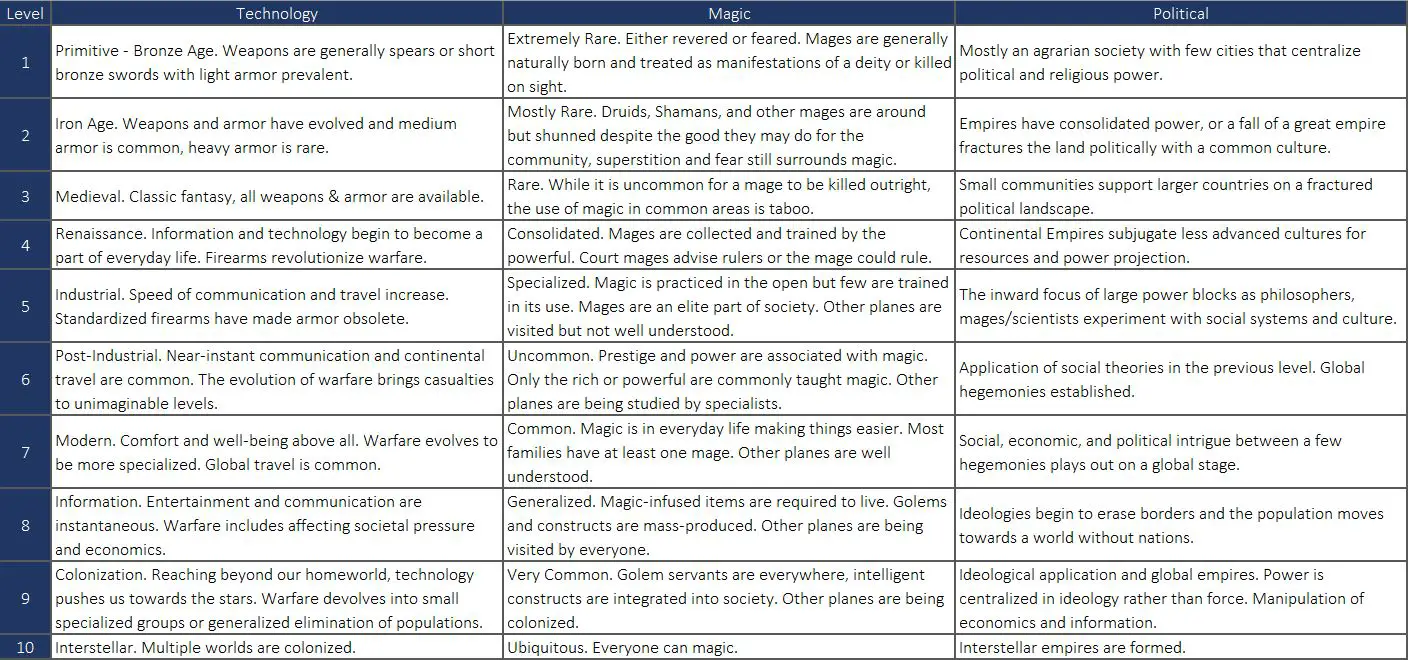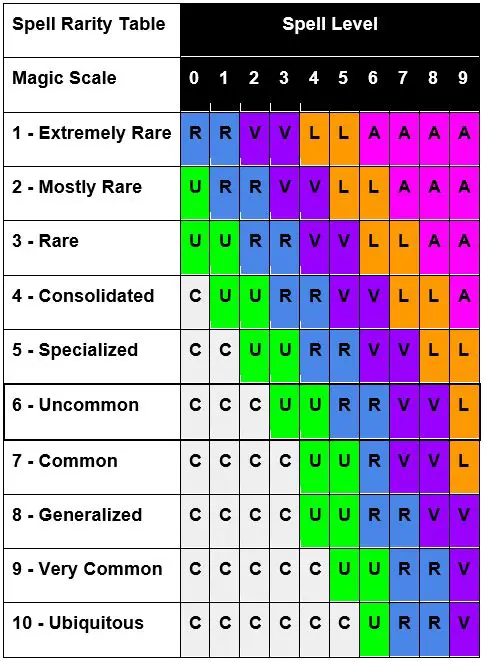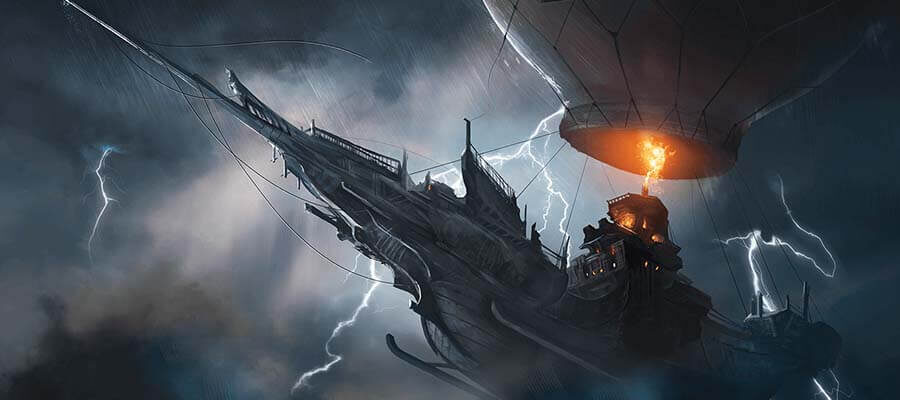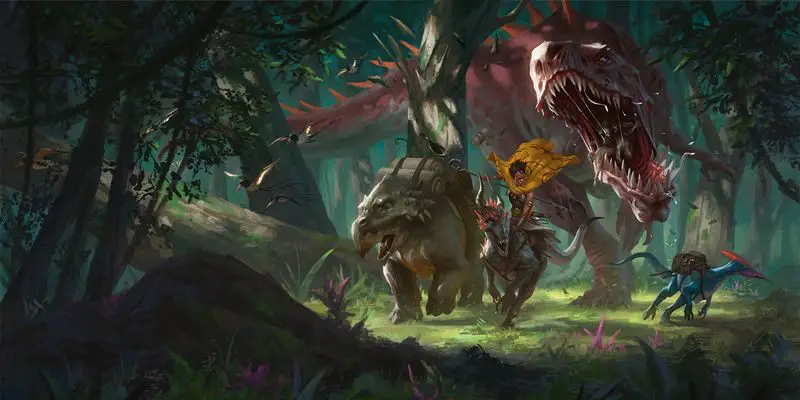Featured D&D 5e WorldCrafting Technology & Magic (world-building) image credit to Wizards of the Coast’s book Acquisitions Incorporated..
Disclaimer: This article contains affiliate links that add gold to our coffers.
Hello and welcome to this edition of WorldCrafting (world-building), where we look at the tools game masters use to craft the worlds that we all love. Today we’re exploring relative technology and magic levels, and we’ll discuss how they interact with each other in your setting.
I prefer the word “WorldCrafting” as opposed to World-Building, as a builder can do something well, but a craftsman is someone who strives towards mastery. I’m always talking about world-building, but WorldCrafting has the right ring to it.
Establishing a Baseline for World-Building
It’s a natural thing for game masters to eventually strike out on their own and begin WorldCrafting, especially if you’ve unwittingly become the forever DM. Building something of your own is a daunting task, and one will need to have the correct tools to do it successfully. Starting with a broad world-building scope, you’ll want to establish what are your ‘tech levels.’ What WorldCrafting silently demands is an implicit understanding of how Technology, Magic, Politics, and other things interact with the population of your campaign.
To help establish what scale we’ll apply, I turn to an old friend: GURPS 3rd edition by Steve Jackson Games. Page 185 of the Basic Set outlines ‘tech levels’ where it describes how this affects weapons and armor, transportation, medicine, power (how work gets done, slave labor vs. machines). With a rich world of magic and the spells described in the RPGs that we love, the descriptions manifest an impressive array of abilities that would transform the world if even a few key people possess them.
How would the spells Mage Hand, Floating Disk, and Telekinesis transform how work gets done? Transmutation magic that transforms the material into different shapes would revolutionize construction and craftsmanship.
Technology, Magic, and Political Scaling
There needs to be an understandable scale that the setting implies through assumptions to make sense of it all. We’ll be using a scale of 1-10 to keep world-building simple (one indicates low levels for the categories, ten indicates high). You can reference this scale for your own world-building.

Level 1
- Technology: Primitive – Bronze Age. Weapons are generally spears or short bronze swords with light armor prevalent.
- Magic: Extremely Rare. Either revered or feared. Mages are generally naturally born and treated as manifestations of a deity or killed on sight.
- Political: Mostly an agrarian society with few cities that centralize political and religious power.
Level 2
- Technology: Iron Age. Weapons and armor have evolved and medium armor is common, heavy armor is rare.
- Magic: Mostly Rare. Druids, Shamans, and other mages are around but shunned despite the good they may do for the community, superstition and fear still surrounds magic.
- Political: Empires have consolidated power, or a fall of a great empire fractures the land politically with a common culture.
Level 3
- Technology: Medieval. Classic fantasy, all weapons & armor are available.
- Magic: Rare. While it is uncommon for a mage to be killed outright, the use of magic in common areas is taboo.
- Political: Small communities support larger countries on a fractured political landscape.
Level 4
- Technology: Renaissance. Information and technology begin to become a part of everyday life. Firearms revolutionize warfare.
- Magic: Consolidated. Mages are collected and trained by the powerful. Court mages advise rulers or the mage could rule.
- Political: Continental Empires subjugate less advanced cultures for resources and power projection.
Level 5
- Technology: Industrial. Speed of communication and travel increase. Standardized firearms have made armor obsolete.
- Magic: Specialized. Magic is practiced in the open but few are trained in its use. Mages are an elite part of society. Other planes are visited but not well understood.
- Political: The inward focus of large power blocks as philosophers, mages/scientists experiment with social systems and culture.
Level 6
- Technology: Post-Industrial. Near-instant communication and continental travel are common. The evolution of warfare brings casualties to unimaginable levels.
- Magic: Uncommon. Prestige and power are associated with magic. Only the rich or powerful are commonly taught magic. Other planes are being studied by specialists.
- Political: Application of social theories in the previous level. Global hegemonies established.
Level 7
- Technology: Modern. Comfort and well-being above all. Warfare evolves to be more specialized. Global travel is common.
- Magic: Common. Magic is in everyday life making things easier. Most families have at least one mage. Other planes are well understood.
- Political: Social, economic, and political intrigue between a few hegemonies plays out on a global stage.
Level 8
- Technology: Information. Entertainment and communication are instantaneous. Warfare includes affecting societal pressure and economics.
- Magic: Generalized. Magic-infused items are required to live. Golems and constructs are mass-produced. Other planes are being visited by everyone.
- Political: Ideologies begin to erase borders and the population moves towards a world without nations.
Level 9
- Technology: Colonization. Reaching beyond our homeworld, technology pushes us towards the stars. Warfare devolves into small specialized groups or generalized elimination of populations.
- Magic: Very Common. Golem servants are everywhere, intelligent constructs are integrated into society. Other planes are being colonized.
- Political: Ideological application and global empires. Power is centralized in ideology rather than force. Manipulation of economics and information.
Level 10
- Technology: Interstellar. Multiple worlds are colonized.
- Magic: Ubiquitous. Everyone can magic.
- Political: Interstellar empires are formed.
I’ve packed some heavy themes with the list, and having an objective view of history is essential to successful WorldCrafting. In the end, build your setting the way that you envision it.
In my opinion, The Forgotten Realms (Faerun) core setting of D&D sits has the following levels: Technology-4, Magic-6, and Political-5. This works well as it brings the romanticism of the Renaissance, combines it with the familiarity of the Modern world through magic, and the discoveries of mad mages to act as antagonists. It also provides themes involving nation-states that allow for isolated adventures.
Applying the Scale to World-Building
What fits best with the setting your building is up to you; most people stick with what the core books have already established. Sticking to core books will make things easier for WorldCrafting as the players will have those critical assumptions already. It is essential to understand the scale as if you start messing with one thing (such as introducing firearms), how will that push the political scale or the magical scale. Generally speaking, I would suggest that Technology and Magic should be your indicator for your Political scale. The political should be somewhere in between the technology and magic levels with a bias towards the higher number.
Mages in Low-Scale Magic
Mages at the low end of the Magic scale (1-3) should be treated differently. Public use of magic could be banned or just taboo. Those practicing evil magic or using unseemly components could be burned alive or imprisoned for their crimes. Magic is generally viewed with a superstitious eye. This could be because a powerful sorcerer in recent memory waged war on the world or because magic is so foreign that people fear it. Power Mages may quickly rise to powerful positions, enchanting or killing their way to subjugating rivals. One could see the Pharaohs of Egypt originally being sorcerers to convince the people that they were gods.
Even in classical Greek stories, city-states wouldn’t go to war without the blessing of a soothsayer, but they wouldn’t keep one in the city for fear of bad omens. History is full of inspiration for magic in your world-building.
Mages in Mid-Scale Magic
Magic becomes more acceptable and generalized in the mid-scale (4-7). Minor spells cast in public are acceptable to most people. Similar to how the Samurai and Knights held a particular political class in society, the Mages in these scales would have special privileges that many common folks don’t enjoy. The higher on the scale your setting goes, the less unique the Mage becomes. This will mean that while most mages are landowners and accountable to the sovereign at level four. They hold no significantly special place in society at level 7. Similar to the way Knights were made obsolete by the longbow and firearms, the commoner mage eliminates the need to control mages through feudal means.
Mages in High-Scale Magic
At the high-end of the scale, magic is everywhere. Children study magic in schools, similar to the way that we learn math and science. Implementation of low-level spells in everyday life is an assumption rather than an exception. This can be applied at a global or cultural level. For example, the rest of the world is a Magic-5, but the high-elves are Magic-8 with cultural tweaks. Be creative with the implementation.
Game Mechanics and Mages
Note: Implementation of the Magic Scale is something completely different. As WorldCrafters, we need to remember that we are playing a game with our friends, and the end goal is for everyone to have fun. Ensure that everyone agrees to rules alteration for the RPG you are playing. Session zero is the best time to cover this.
I like to use a Rarity System to adjust for the Magic Scale in my games. It assigns rarity levels to all the spells in the game, and I adjust it as it scales up or down. In D&D 5e, the divine classes are a special case, and you will need to outline any changes clearly to anybody wanting to play one, more on that below.
I use the following terminology for rarity:

Level 0 spells are Cantrips.
Spell Rarity and Scale

Note on Divine Classes in D&D 5e: With the entire spell list accessible to the divine classes, it would be difficult to restrict spells. When modifying a rule, the simpler, the better. In this case, I would implement an approval system where spell access is granted by a clergy, patron, or ritual. All Common spells are automatically given, and Uncommon and up would need unique circumstances to unlock either the entire spell list at that level or select spells as the rarity goes up. This will allow the gameplay to be consistent with the rarity system without disrupting the established rules excessively.
Magic Items and the Magic Scale
Many settings have different levels of magic items. The world of Harry Potter has a nearly endless supply of fanciful magic items that do all sorts of things, and they are so common that even children have full access to them at a young age.
On the flip side, Middle Earth of the Hobbit and Lord of the Rings have magic items, but they are rare, and each has a history or saga to the item itself. Even a simple magic item such as a +1 Sword of Goblins Bane (Sting) is a wondrous, unique gift. Determining the commonality of the magic items in your setting will go a long way to establishing the assumptions about the level of magic.
In the given examples, magic items provide us with insight into the settings; in Harry Potter’s world, you can assume that magic is prevalent and a replacement for a lot of technology. Middle Earth makes it implicitly clear to readers that magic is rare and powerful.
Game Mechanics and Magic Items
When looking at magic items, the same idea that we applied to spells could be applied—taking the rarity of the item with a base level of 6 as the standard. As magic continues to become more common, so too would the availability of magic items. Decreasing/increasing the rarity of items a step every 1-2 degrees on the scale would be sensible.
Be careful when dealing with Legendary or artifact items as they might need to be kept at a higher rarity for balancing out your setting. The same applies to the more common magic items. Game designers set challenge ratings and balance encounters with the assumption that the party will have access to magic items at the current level.
Technology World-Building Scale
There is a lot of literature out in our world that explains the history of technology and how it has evolved throughout history. I would encourage you to find videos and books on the subject as those would better answer any questions. Just try to remember the link between technology and magic. In many cases, the absence of magic causes technology to develop. People and civilizations select the easiest path forward, and that path would default to magic over technology or a hybrid at best.
Political World-Building Scale
It is crucial to keep in perspective the political and societal ramifications of magic and technology. When WorldCrafting, consistency is essential. A setting’s political background and upkeep should match the societal structures that support your themes. The other side of this is establishing governmental archetypes to fit the story’s theme you’re crafting.
Imaginative Application
The most important thing to remember is that the application of the scales within the setting you’re crafting needs to be consistent. Give careful thought and consideration to the consequences of having high technology and low magic, or the opposite. How would the rulers of a centralized state political system look to leverage the talents of the magically inclined (Full Metal Alchemist)? If magic and technology are both at a reasonably advanced state, what are the reasons that technology wasn’t hindered by the presence of magic?
WorldCrafting needs to note the prevalence of magic items, the everyday use of spells to make life more comfortable. The use of magic as a replacement for technology is essential to keep in mind. In our modern society, it is easy to forget that life-changing technology was primarily a curiosity of the rich or powerful before the Industrial Revolution. I included a political scale to draw attention to the viewpoint of commoners. If a technology exists but it isn’t widely available for the ordinary person to use, then it wouldn’t have a significant effect on society as a whole; it would just be a novelty for the upper classes.
Asking questions in the initial phases of WorldCrafting will help you apply any changes to lore needed to clear up any inconsistencies or questions that your players will have. If you have already established a campaign and are looking to clean up the background in real-time, I would suggest having a clear understanding of your goal is the first step and the purpose of this article.
World-Building Wrap Up
Understanding the interplay of Technology, Magic, and Political forces in your setting as you’re WorldCrafting is important. The more you pay attention to the details like this at the beginning, the more your players will notice and want to immerse into the setting of your creation. I love to see my players enthralled by the lore of my setting, messaging me with questions at 1 AM because they can’t sleep due to their minds being busy with the world I crafted.
Like any good piece of art, the background should be imperceptible, but it’s essential to frame the story you craft or it will seem incomplete.
You can find hone your GM and world-building skills with more articles by RPG Storycraft and DM resources on Flutes Loot!




